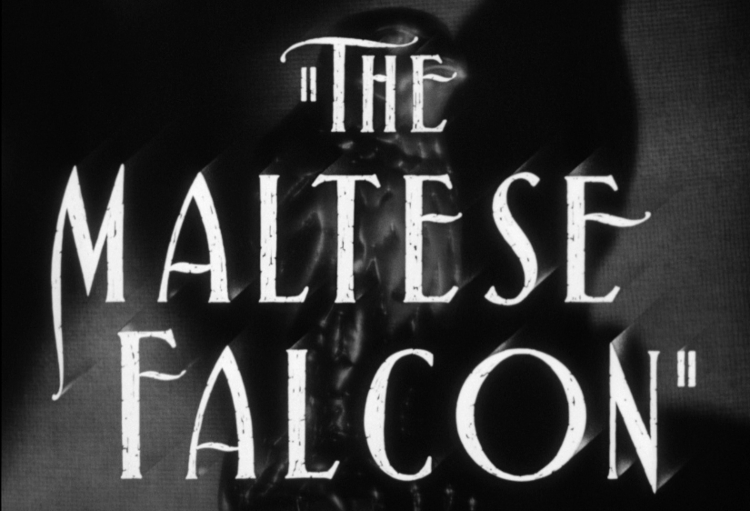
Last month, Dateline Bangkok reviewed Touch Of Evil, the last of the original film noir cycle. Today is the turn of the first film in the cycle, The Maltese Falcon, by John Huston (a remake of an earlier film by Roy Del Ruth).
Humphrey Bogart stars as Sam Spade, in the first of his definitive noir detective roles. (He later played Philip Marlowe in The Big Sleep.) This was Bogart’s first heroic performance, after previously being typecast as a villain in supporting roles. What makes Bogart’s character so interesting is his moral ambiguity: he is prepared to sleep with his business partner’s wife, only to reject her once she is widowed.
Like Rick Blaine, Bogart’s character in Casablanca, Spade’s alliances appear to shift, until his cynical, self-protecting façade disappears when he puts love aside to do the right thing. There are also other Casablanca connections: along with Bogart, Sydney Greenstreet and Peter Lorre also feature in both films, in similar roles.
Lorre, a major star in Germany before World War II, played sinister villains in numerous noir thrillers. He is perfect as the gardenia-scented Joel Cairo, twisting a phallic walking-cane and even putting its tip to his lips. Greenstreet is wonderful as the amiable Kasper Gutman, constantly chuckling to himself. He would develop further comic mannerisms in Casablanca, such as his habit of casually swatting flies.
Elisha Cook has an unbilled supporting role and, as always, plays the unlucky fall-guy. He previously appeared with Lorre in Stranger on the Third Floor, which has sometimes been cited as the first true noir.
Stranger on the third Floor has more shadows and Expressionist lighting than The Maltese Falcon, so it certainly looks like a noir film, though it was The Maltese Falcon that established the archetypes of the noir genre. The Maltese Falcon’s cynical detective, duplicitous femme fatale, and ambiguous morality formed the basis of many subsequent noir thrillers.
The film’s dialogue seems more authentic than the contrived innuendo of The Big Sleep. Also, Bogart is amazingly fast with his lines: his quick delivery makes this performance more energetic than the world-weary characters he played in other films of the period. It’s a largely studio-bound film, though the sets all have ceilings to create a claustrophobic atmosphere and increase the tension.
The Maltese falcon itself, a bejewelled statuette, is merely a MacGuffin, a plot device intended to motivate the central characters. In a line adapted from The Tempest, Spade calls it “the stuff that dreams are made of.”
Humphrey Bogart stars as Sam Spade, in the first of his definitive noir detective roles. (He later played Philip Marlowe in The Big Sleep.) This was Bogart’s first heroic performance, after previously being typecast as a villain in supporting roles. What makes Bogart’s character so interesting is his moral ambiguity: he is prepared to sleep with his business partner’s wife, only to reject her once she is widowed.
Like Rick Blaine, Bogart’s character in Casablanca, Spade’s alliances appear to shift, until his cynical, self-protecting façade disappears when he puts love aside to do the right thing. There are also other Casablanca connections: along with Bogart, Sydney Greenstreet and Peter Lorre also feature in both films, in similar roles.
Lorre, a major star in Germany before World War II, played sinister villains in numerous noir thrillers. He is perfect as the gardenia-scented Joel Cairo, twisting a phallic walking-cane and even putting its tip to his lips. Greenstreet is wonderful as the amiable Kasper Gutman, constantly chuckling to himself. He would develop further comic mannerisms in Casablanca, such as his habit of casually swatting flies.
Elisha Cook has an unbilled supporting role and, as always, plays the unlucky fall-guy. He previously appeared with Lorre in Stranger on the Third Floor, which has sometimes been cited as the first true noir.
Stranger on the third Floor has more shadows and Expressionist lighting than The Maltese Falcon, so it certainly looks like a noir film, though it was The Maltese Falcon that established the archetypes of the noir genre. The Maltese Falcon’s cynical detective, duplicitous femme fatale, and ambiguous morality formed the basis of many subsequent noir thrillers.
The film’s dialogue seems more authentic than the contrived innuendo of The Big Sleep. Also, Bogart is amazingly fast with his lines: his quick delivery makes this performance more energetic than the world-weary characters he played in other films of the period. It’s a largely studio-bound film, though the sets all have ceilings to create a claustrophobic atmosphere and increase the tension.
The Maltese falcon itself, a bejewelled statuette, is merely a MacGuffin, a plot device intended to motivate the central characters. In a line adapted from The Tempest, Spade calls it “the stuff that dreams are made of.”


0 comment(s):
Post a Comment